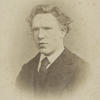More about Hospital at Saint-Rémy
- All
- Info
- Shop

Sr. Contributor
Van Gogh painted Hospital at Saint Remy ( also known as Trees in the Garden of the Saint-Paul Hospital) in 1889, just after he was admitted to the asylum on May 8, 1889.
Van Gogh was voluntarily committed to Saint-Paul Hospital in St-Remy and was not able to leave, only sketching and painting its walled garden from his cell window. He sent his brother, Theo, his paintings of the garden, writing, “When you receive the canvases that I have done in the garden, you will see that I am not too melancholy here.” This painting is of the pine trees in the courtyard, though he also created still lives of the flora in the garden, or in vases. Most famously, he recorded a night time view outside of his window in Starry Night.
Prior to being admitted to the hospital, van Gogh was experiencing hallucinations, which he interpreted as mystical revelations. After an altercation with his friend Paul Gauguin, an assault of voices caused him to amputate his left ear and present it to a woman at the brothel they both frequented. In the previous two years van Gogh painted with manic-like productivity, totaling over 200 pieces, 150 of which were created in 1889.
At St-Remy, his doctor was Dr Theophile Peyron. Peyron was a naval doctor and militaristically strict. Van Gogh’s treatment consisted of hydrotherapy, or two-hour baths, twice a week. He was given the cold version which meant he sat in an ice bath to invigorate and shock his body and brain. At the hospital, his painting was less consistent and productive compared to his pre-hospitalization prolificness. He was, however, given an extra room to use as a studio, and later was allowed to work outside, which led to his paintings of the Provence landscape, including his wheatfield series. But his mental health fluctuated and was he was prohibited from painting during bad episodes of confusion.
One common rumor of van Gogh’s time at Saint-Paul was that he ate yellow paint to raise his spirits. Though he did indeed eat paint and washed it down with turpentine, his physician believed it was because he wanted to poison himself. Though it's true he was having a hard time at the asylum, there may have been another reason he was consuming paint. Van Gogh was a prolific drinker and his drink of choice was absinthe, which may have been introduced to him by Henri de Toulouse Lautrec, whose signature cocktail included the spirit. Absinthe is a bitter green liqueur flavored with anise and wormwood, containing up to 74% alcohol. It was banned in France in 1922, but is still commonly consumed, especially in Arles and St-Remy, where van Gogh spent most of his life.
The absinthe may have been a factor in aggravating a genetic disposition to mental illness which ran in van Gogh's family. His pica, or compulsion to eat paint and turpentine, may have been triggered by wormwood, which is used to treat poor appetite. Before being admitted to the hospital, he had to be restrained from drinking about a quart of turpentine from the bottle. Wormwood also contains pinene, a chemical found in turpentine, which may have explained his affinity for the taste and the motivation behind his strange compulsion. Thujone, also found in wormwood, is known to cause stomach issues, similar to those van Gogh experienced, as well as nervous system issues like mood swings, convulsions, and brain damage. Thujone’s effects were especially strong in combination with nicotine, and van Gogh was also a heavy smoker.
Sources
- “Did van Gogh eat yellow paint thinking it would raise his spirits?” Van Gogh Museum. https://www.vangoghmuseum.nl/en/art-and-stories/vincent-van-gogh-faq/di…. Accessed February 21, 2020.
- “Hospitalization.” Van Gogh Museum. https://www.vangoghmuseum.nl/en/art-and-stories/vincents-life-1853-1890…. Accessed February 21, 2020.
- Khoshbin, Shahram, and Joel T Katz. “Van Gogh's Physician.” Open forum infectious diseases Vol 2, 3 (June 15, 2015). doi:10.1093/ofid/ofv088.
- Van Gogh, Vincent. “Letter from Vincent van Gogh to Theo van Gogh at Saint-Remy, c. 2 June, 1889.” http://www.webexhibits.org/vangogh/letter/20/593.htm. Accessed February 22, 2021.
- Van Gogh, Vincent.“To Theo van Gogh. Saint-Rémy-de-Provence, on or about Thursday, 23 May 1889.” Vincent van Gogh, the Letters. Van Gogh Museum. http://www.vangoghletters.org/vg/letters/let776/letter.html. Accessed February 21, 2021.
- Vernon, McCay, and Marjie L. Baughman. "Art, Madness, and Human Interaction." Art Journal 31, no. 4 (1972): 413-20. doi:10.2307/775545.
- Soth, Lauren. "Van Gogh's Agony." The Art Bulletin 68, no. 2 (1986): 301-13. Accessed February 21, 2021. doi:10.2307/3050939.
- “Why van Gogh Ate Paint.” The Washington Post. November 24, 1988. https://www.washingtonpost.com/archive/lifestyle/1988/11/25/why-van-gog….
- Womack, Josh. “Cryotherapy’s Shocking Truth.” Entrepreneur. September 16, 2020. https://www.entrepreneur.com/article/355692.













